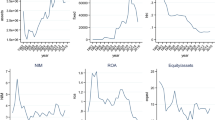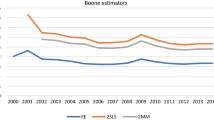
Overview
Access this book
Tax calculation will be finalised at checkout
Other ways to access
About this book
Similar content being viewed by others
Keywords
Table of contents (7 chapters)
-
Front Matter
-
Back Matter
Reviews
Banking reform is critical to the health of national economies and global financial markets alike. In this book, Saez achieves what few others have: a serious, sustained and comparative analyis of the political economy conditions that either stall or promote such reform. His findings should be read by policymakers, investors, and all concerned about economic development and globalization. - Kathleen R. McNamara, Associate Professor of Government, Georgetown University
"Since globalization went into high gear in the wake of the Cold War, two giant countries have surged to the forefront of rapid economic development by opening to the outside world: India and (above all) China. While both have attracted their share of scholarly attention, comparisons have been rare and usually fairly general. This brilliant, pioneering book by Dr. Lawrence Saez is the first and best comparative analysis of the financial sectors of these two pace-making developers since both opted for economic globalization." - Lowell Dittmer, Professor of Political Science, University of California at Berkeley, and author of Informal Politics in East Asia.
"Managing banking reform has been one of the most challenging tasks for bank policymakers and regulators in every country that has attempted to do so. India and China pose particular difficulties arising from entrenchment, China on account of its political structure and India on account of its poor, yet politically active, rural population. Saez's book provides a thorough and comprehensive analysis of these issues. Along the way, a useful history of the growth of the banking system is also presented, a must-read for the economic and political historian working in the area. Banking Reform in India and China is of further value given the unexpectedly sustained rise of China and the recent economic growth in India. The book, especially the discussion on central bank independence, brings out the importance of financial reform in a newly growing economy and thus provides a valuable conceptual perspective to students of institution-driven growth." - Dr. Rafiq Dossani, Senior Research Scholar, Asia/Pacific Research Center, Stanford University
"Lawrence Saez has written a finely tuned, cogent and careful analysis of the banking systems in China and India, He is both informative, balanced and thorough while avoiding the rhetorical embellishments of some authors. Saez has given us in this compact book a solid introduction to the process in India and China. This is an important task and he has done it very well." - Joyce K Kallgren, University of California
"Banking Reform in India and China is the most comprehensive comparative analysis of the two countries' banking systems that I have read thus far. Students of India and China will find the comparative approach helpful in elucidating why the content and outcomes of banking reform has differed substantially in the two countries - and readers interested in emerging market economies and financial crises more generally, will be interested to learn how the banking reform experience in India and China challenges conventional assumptions about the relationship between corporate governance and the banking system, and the relative importance of central bank independence." - Kellee Tsai, Department of Political Science, Johns Hopkins University
About the author
Bibliographic Information
Book Title: Banking Reform in India and China
Authors: Lawrence Sáez
DOI: https://doi.org/10.1057/9781403981257
Publisher: Palgrave Macmillan New York
eBook Packages: Palgrave Economics & Finance Collection, Economics and Finance (R0)
Copyright Information: Lawrence Sáez 2004
Hardcover ISBN: 978-0-312-23935-0Published: 28 January 2004
Softcover ISBN: 978-1-349-38687-1Published: 28 January 2004
eBook ISBN: 978-1-4039-8125-7Published: 16 January 2004
Edition Number: 1
Number of Pages: X, 144
Number of Illustrations: 2 b/w illustrations
Topics: Macroeconomics/Monetary Economics//Financial Economics, International Political Economy, International Relations, Asian Politics, Banking



